The latest 300-510 dumps exam questions released today are verified, correct and valid, candidates can use the PDF and VCE exam tools provided by leads4pass to help you practice all exam questions and guarantee you 100% success on the Cisco 300-510 SPRI exam(Implementing Cisco Service Provider Advanced Routing Solutions).
The latest 300-510 dumps are available to all candidates taking the Cisco 300-510 SPRI exam: https://www.leads4pass.com/300-510.html.
PS. Use discount code “Cisco”, Enjoy 15% off.
Free download of 2022 updated 300-510 dumps pdf:
https://drive.google.com/file/d/1TPDDk4TSJSokzb-frVYzD_0S5jp9PoVI/
The latest Cisco 300-510 Dumps exam questions and answers are shared online:
| Number of exam questions | Update time | Exam name | Previous issue |
| 15 | Sep 14, 2022 | Implementing Cisco Service Provider Advanced Routing Solutions (SPRI) (300-510) |
Question 1:
DRAG DROP
Compare different features between OSPFv2 and OSPFv3. Drag and drop the descriptions of OSPF from the left onto the correct OSPF versions on the right.
Select and Place:

Correct Answer:

Question 2:
DRAG DROP
Drag the IPv6 tunneling mechanisms on the left to match the correct manual or automatic tunneling category on the right.
Select and Place:

Correct Answer:

Question 3:
DRAG DROP
Drag and drop the features from the left into the order of operations for SRv6 SRH field creation and forwarding on the right.
Select and Place:
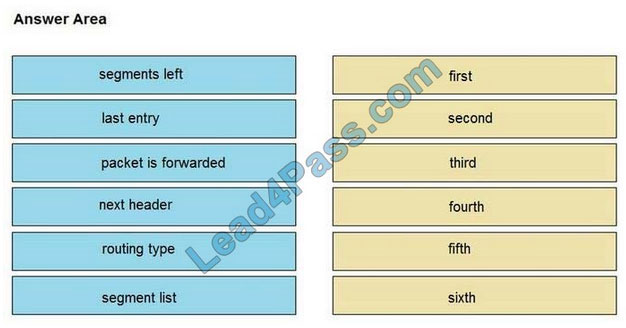
Correct Answer:
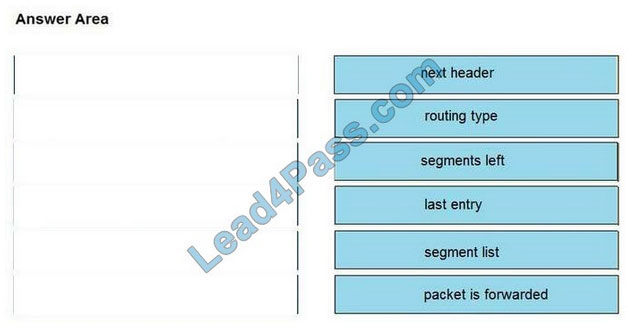
First – next header Second – routing type Third – segments left Fourth – last entry Fifth – segment list sixth – packet is forwarded
Question 4:
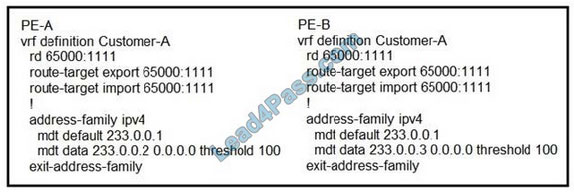
Refer to the exhibit. Which tree does multicast traffic follow?
A. shared tree
B. MDT default
C. source tree
D. MDT voice
Correct Answer: B
Question 5:
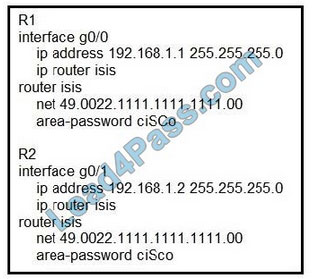
Refer to the exhibit. After you applied these configurations to routers R1 and R2, the two devices could not form a neighbor relationship. Which reason for the problem is the most likely?
A. The two routers cannot authenticate with one another.
B. The two routers have the same area ID.
C. The two routers have the same network ID.
D. The two routers have different IS-types.
Correct Answer: A
Question 6:

Refer to the exhibit. Which effect of this configuration is true?
A. It sets the keepalive timer to 30 seconds and the hold timer to 240 seconds.
B. It sets the keepalive timer to 30 milliseconds and the hold timer to 240 milliseconds
C. It sets the hold timer to 30 milliseconds and the keepalive timer to 240 milliseconds
D. It sets the hold timer to 30 seconds and the keepalive timer to 240 seconds
Correct Answer: A
Question 7:

Refer to the exhibit. A network operator is working to filter routes from being advertised that are covered under an aggregate announcement. The receiving router of the aggregate announcement block is still getting some of the more specific routes plus the aggregate.
Which configuration change ensures that only the aggregate is announced now and in the future if other networks are to be added?
A. Configure the summary-only keyword on the aggregate command
B. Set each specific route in the AGGRO policy to drop instead of suppress-route
C. Filter the routes on the receiving router
D. Set each specific route in the AGGRO policy to remove instead of suppress-route
Correct Answer: A
Question 8:

Refer to the exhibit. A network operator is getting the route for 10.11.11 0/24 from two upstream providers on #XR3. The network operator must configure #XR3 to force the 10.11.11.0/24 prefix to route via the next hop of 10.0.0.9 as primary when available.
Which of these can the operator use the routing policy language for, to enforce this traffic forwarding path?
A. weight of 0 on the prefix coming from 192.168.0.2
B. lower local preference on the prefix coming from 192.168.0.2
C. higher local preference on the prefix coming from 192.168.0.1
D. weight of 100 on the prefix coming from 192.168.0.1
Correct Answer: A
Question 9:

Refer to the exhibit. After troubleshooting an OSPF adjacency issue, routers 1, 2, and 3 have formed OSPF neighbor relationships. Which statement about the configuration is true?
A. Router 2 receives Type 5 LSAs from router 1 for its connected subnets
B. Router 2 uses router 3 as the next hop for 192.168.0.0/24
C. Router 2 uses router 1 as the next hop for 192.168.0.0/24
D. Router 2 receives Type 7 LSAs from router 3 for its connected subnets
Correct Answer: A
Question 10:
A network consultant is troubleshooting IS-IS instances to identify why a routing domain is having communication problems between the two instances. Which description of the possible cause of issues in the routing domain is true?
A. The same interface cannot be advertised in two different IS-IS instances
B. The IS-IS “ISP” and “ISP2” instances are unrelated and unable to intercommunicate
C. The configured IS-IS NSEL value is not allowing the routing systems to establish a neighborship
D. The interface mode IP router is-is command was not included in the script
Correct Answer: A
Question 11:
What is used by SR-TE to steer traffic through the network?
A. shortest path calculated by IGP
B. dynamic rules
C. path policy
D. explicit maps
Correct Answer: C
Question 12:
Which statement about enabling segment routing for IGPs is true?
A. Segment routing must first be enabled under the routing process and then globally
B. Segment routing must first be enabled globally and then under the routing process
C. Segment routing can be enabled only under the routing process
D. Segment routing can be enabled only globally
Correct Answer: B
Question 13:
Which task is performed when troubleshooting LDP?
A. Execute the ping utility to generate information about the MAC addresses used along the path
B. Verify that MPLS is disabled globally and enabled on the necessary interfaces on a per-interface basis
C. Execute the traceroute utility to generate information about the labels used along the path
D. Verify that Cisco Express Forwarding has been disabled on the network
Correct Answer: C
Question 14:
Assume that the R1 router is enabled for PIM-SM and receives a multicast packet sourced from 172.16.1.100, and the R1 router has multicast receivers on the Gi0/1, Gi0/2, Gi0/3, and Gi0/4 interfaces.
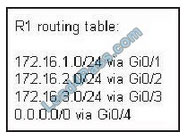
The multicast packet from the 172.16.1.100 source must arrive on which interface on the R1 router for it to be forwarded out to the other interfaces.
A. Gi0/1
B. Gi0/2
C. Gi0/3
D. Gi0/4
E. Gi0/1 or Gi0/2 or Gi0/3 or Gi0/4
F. Gi0/2 or Gi0/3
G. Gi0/1 or Gi0/4
Correct Answer: A
Question 15:
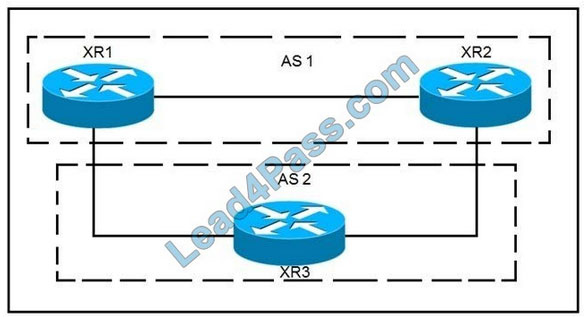
Refer to the exhibit. XR1 and XR2 are sending the prefix 10.11.11.0/24 to XR3. A configured policy on XR1 is incorrectly prepending AS path 11 11 12 12 onto this prefix. A network operator wants to add a policy onto XR3 that will not allow the falsely prepending prefix from being installed.
Which policy configuration applied to the XR3 neighbor configuration for XR1 can accomplish this requirement without impact on other or future received routes?
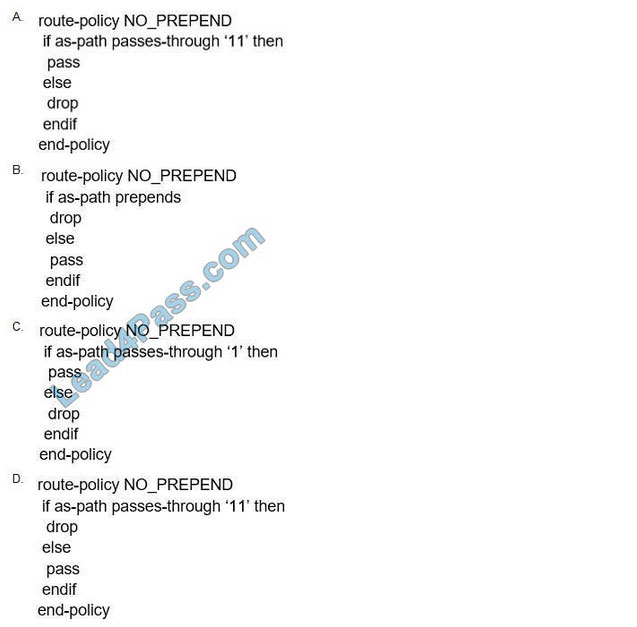
A. Option A
B. Option B
C. Option C
D. Option D
Correct Answer: D
…
Free download of 2022 updated 300-510 dumps pdf:
https://drive.google.com/file/d/1TPDDk4TSJSokzb-frVYzD_0S5jp9PoVI/
The above Cisco 300-510 Dumps exam contains 13 questions that you can practice to improve yourself. The latest version of the 300-510 dumps, updated in September 2022, contains 135 exam questions and answers that candidates can practice to help them successfully pass
Cisco 300-510 SPRI exam. You are welcome to use the latest version of 300-510 dumps https://www.leads4pass.com/300-510.html. Escort your career leap.

